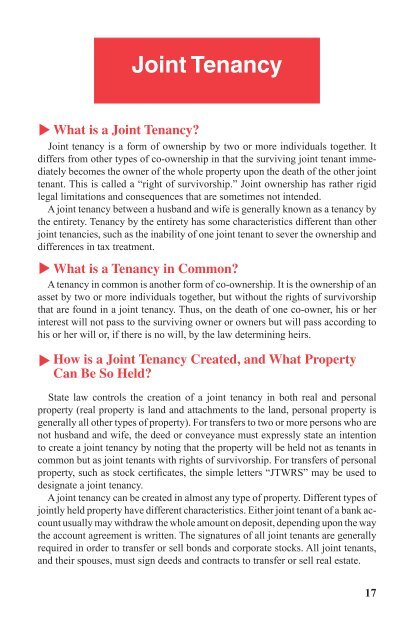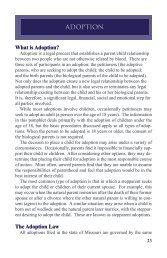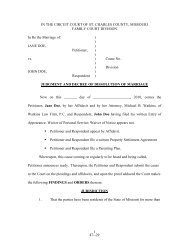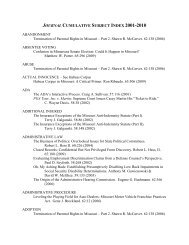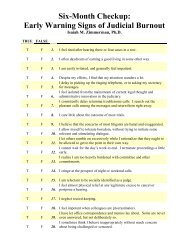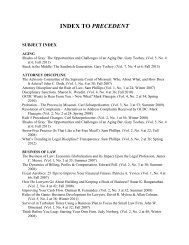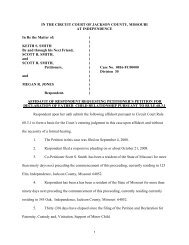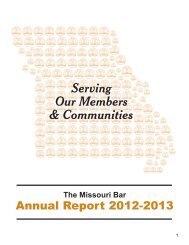Probate Law Resource Guide (PDF) - the Missouri Bar
Probate Law Resource Guide (PDF) - the Missouri Bar
Probate Law Resource Guide (PDF) - the Missouri Bar
- No tags were found...
You also want an ePaper? Increase the reach of your titles
YUMPU automatically turns print PDFs into web optimized ePapers that Google loves.
Joint Tenancy<br />
▼<br />
Joint tenancy is a form of ownership by two or more individuals toge<strong>the</strong>r. It<br />
differs from o<strong>the</strong>r types of co-ownership in that <strong>the</strong> surviving joint tenant immediately<br />
becomes <strong>the</strong> owner of <strong>the</strong> whole property upon <strong>the</strong> death of <strong>the</strong> o<strong>the</strong>r joint<br />
tenant. This is called a “right of survivorship.” Joint ownership has ra<strong>the</strong>r rigid<br />
legal limitations and consequences that are sometimes not intended.<br />
A joint tenancy between a husband and wife is generally known as a tenancy by<br />
<strong>the</strong> entirety. Tenancy by <strong>the</strong> entirety has some characteristics different than o<strong>the</strong>r<br />
joint tenancies, such as <strong>the</strong> inability of one joint tenant to sever <strong>the</strong> ownership and<br />
differences in tax treatment.<br />
▼<br />
What is a Joint Tenancy<br />
What is a Tenancy in Common<br />
A tenancy in common is ano<strong>the</strong>r form of co-ownership. It is <strong>the</strong> ownership of an<br />
asset by two or more individuals toge<strong>the</strong>r, but without <strong>the</strong> rights of survivorship<br />
that are found in a joint tenancy. Thus, on <strong>the</strong> death of one co-owner, his or her<br />
interest will not pass to <strong>the</strong> surviving owner or owners but will pass according to<br />
his or her will or, if <strong>the</strong>re is no will, by <strong>the</strong> law determining heirs.<br />
▼<br />
How is a Joint Tenancy Created, and What Property<br />
Can Be So Held<br />
State law controls <strong>the</strong> creation of a joint tenancy in both real and personal<br />
property (real property is land and attachments to <strong>the</strong> land, personal property is<br />
generally all o<strong>the</strong>r types of property). For transfers to two or more persons who are<br />
not husband and wife, <strong>the</strong> deed or conveyance must expressly state an intention<br />
to create a joint tenancy by noting that <strong>the</strong> property will be held not as tenants in<br />
common but as joint tenants with rights of survivorship. For transfers of personal<br />
property, such as stock certificates, <strong>the</strong> simple letters “JTWRS” may be used to<br />
designate a joint tenancy.<br />
A joint tenancy can be created in almost any type of property. Different types of<br />
jointly held property have different characteristics. Ei<strong>the</strong>r joint tenant of a bank account<br />
usually may withdraw <strong>the</strong> whole amount on deposit, depending upon <strong>the</strong> way<br />
<strong>the</strong> account agreement is written. The signatures of all joint tenants are generally<br />
required in order to transfer or sell bonds and corporate stocks. All joint tenants,<br />
and <strong>the</strong>ir spouses, must sign deeds and contracts to transfer or sell real estate.<br />
1117


